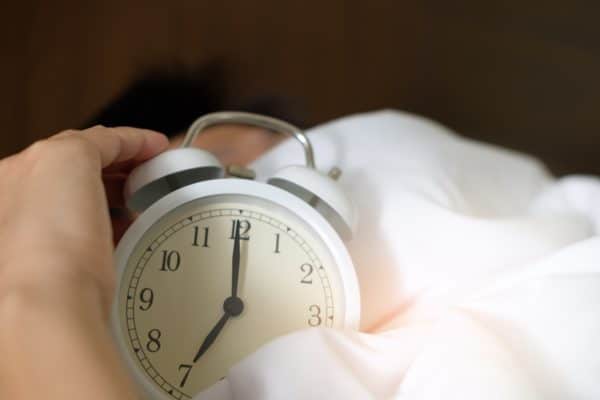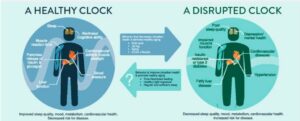
Meet Your Circadian Rhythm
The rotation of the earth results in a 24-hour light and dark cycle. All life on this planet has adapted and/or evolved with the exposure to daylight and darkness for hundreds of millions of years. Many of us know the circadian rhythm is responsible for our diurnal habits (sleeping at night, and wakefulness during the day). But the effect the circadian rhythm has on our health might be less common knowledge.
Research has observed that circadian rhythm is intricately responsible for coordinating function and maintaining homeostasis in every cell of our body. Each cell in our body has its clock that times cellular activity based on the cell’s type and role. Disruption of the circadian rhythm has been associated with an increased risk for multiple diseases/disorders such as cancer, infertility, immune disorders, obesity, cardiovascular disease, depression, and anxiety.
This is important because modern life imposes many insults to the internal and external modulators of this natural rhythm. Circadian rhythm disruption can result from:
- Shift work (classified as a class 2 carcinogen, since 2007)
- Jet lag (chronic) – pilots, frequent travel
- Abundance and accessibility to food, and associated eating behaviors: >12 eating periods, continuous daytime eating (excessive snacking), and nighttime eating.
- Artificial light exposure (especially at night)
- Lack of natural sunlight exposure (especially during the day)
- Electromagnetic field exposure (cell phones, computers, Wi-Fi)
Your circadian rhythm is governed by the body’s master clock, known as the suprachiasmatic nucleus (SCN), found in the hypothalamus of the brain. The clock inside every cell in our body is tuned by the SCN and light influences its activity. The retina of our eyes contains specific cells to detect spectrums of light (specifically sunlight, because it includes a variety of light spectrums throughout the day) which sends signals to the master clock and then affects our cellular/organ function and behavior.
When the master clock is activated by light it tells the Pineal gland to stop producing melatonin (the hormone for sleep) and alters the expression of our genes to support daytime activity. (7-13% of genes are under circadian control). This has a cascade effect on function, temperature, blood pressure, energy production and expenditure, the synchronization of metabolic and hormone pathways, mental stability and alertness, learning and memory-forming capacity, and more.
Because we are diurnal creatures (opposite of nocturnal), our biology works to support activity during the day and restoration and repair at night while we sleep. When there is a lack of darkness or light exposure after the sun sets, our photoreceptors continue to send signals to our master clock that it is still daylight. Since light facilitates daytime activity and suppresses melatonin production, this confuses our master and cellular clocks. Melatonin is essential for not only falling asleep but for getting quality sleep. The importance of sleep is a discussion in itself, but note there are three distinct and purposeful phases of sleep, and without melatonin, phase 3 (deep sleep) is impaired or absent. It is in this phase where DNA repair, detoxification, and the clean-up of bi-products of cellular activity (oxidative stress) take place. Melatonin levels have also been confirmed to be powerful in the modulation of the immune system, and low levels have strong implications of diseases like cancer.
As you begin to understand this mechanism, you can see how our modern world challenges circadian health. Wakefulness during night hours disrupted sleep, jet lag, use of blue light (cell phones, T.V, computer), or lack of darkness at night (night lights/light pollution) can affect sleep quality, circadian rhythm, and function at the cellular level.
What are the symptoms associated with a disrupted circadian rhythm?
- Disordered sleep – trouble falling asleep/staying asleep
- Daytime sleepiness
- Weight gain or trouble losing weight despite diet/exercise
- Difficulty concentrating
- Coordination problems
- Poor work or school performance
- Digestive problems
- Headaches

What can you do about it?
- Sleep schedule: The ideal model is to sleep at night and stay consistent with a regular bedtime. However, for shift workers, this may not be doable. Try your best to keep consistency with shifts (avoid rotating shifts if at all possible) and stick to your sleep schedule even on off days. Keeping a predictable pattern, along with following the rest of the recommendations, will help with optimizing circadian rhythm entrainment.
- Eating pattern: When you eat matters. Erratic eating patterns/nighttime eating can disrupt circadian rhythm independently from sleep/light patterns. Eating all meals within an 8-10 hour window has the potential to reverse diabetes and obesity. It can also be protective against metabolic disease in shift workers, without any additional changes made to the diet.
- Time-restricted feeding should follow daylight patterns to optimize effectiveness. For example, if your first meal/caffeine/beverage is consumed at 8 AM, your last bite of food/drink should be taken by 6 pm to achieve an 8-hour feeding window.
- Sleeping environment: Keep the room cool and dark. Use blinds/curtains and unplug electronics emitting light to block light pollution.
- Morning sunlight: First in the morning expose your eyes to natural outdoor light without sunglasses for approximately 20 minutes.
- Blue light protection: After the sun goes down, protect your eyes from blue light. If you can’t avoid electronics, use blue-light-blocking apps or consider purchasing blue light glasses.
- Electromagnetic field (EMF) exposure: Low-frequency EMFs are shown to interfere with our melatonin production, change EEG activity (brain waves), and alter the excitatory state of our cells. Unplug your Wi-Fi router at night and put your devices on airplane mode – DON’T forget your kid’s devices too!
If you find yourself having trouble with your sleep, feeling rested, or requiring excessive daytime naps, then this is a good indicator that your circadian rhythm may be off. Consider working with a functional medicine provider to help determine the right testing and monitoring strategies for you and to provide targeted lifestyle changes and supplements to optimize this foundational system for health.
VSMG believes in total wellness and provides our members with the tools and support they need to find success! Contact us today to learn how to become a member for free.
References:
-
- Hastings, M. H., Reddy, A. B., & Maywood, E. S. (2003). A clockwork web: circadian timing in brain and periphery, in health and disease. Nature Reviews Neuroscience, 4(8), 649.
- Manoogian, E. N., & Panda, S. (2017). Circadian rhythms, time-restricted feeding, and healthy aging. Aging research reviews, 39, 59-67.
- Duffy, J. F., & Czeisler, C. A. (2009). Effect of Light on Human Circadian Physiology. Sleep medicine clinics, 4(2), 165–177. doi:10.1016/j.jsmc.2009.01.004
- LeGates, T. A., Fernandez, D. C., & Hattar, S. (2014). Light as a central modulator of circadian rhythms, sleep and affect. Nature Reviews Neuroscience, 15(7), 443.
- Manoogian, E. N., & Panda, S. (2017). Circadian rhythms, time-restricted feeding, and healthy aging. Aging research reviews, 39, 59-67.



